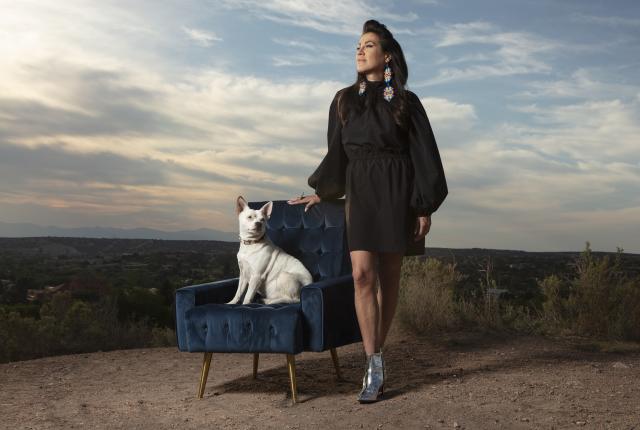AMBER-DAWN BEAR ROBE WAS GIVEN HER SIKSIKA NAME, Many Butterfly Woman, from a relative’s dream. In it, a tepee was covered in butterflies, but as the dreamer approached, the butterflies took flight, swirling around the tepee before fluttering away. As a curator, an educator, and the director of the Indian Market Indigenous Fashion Show, Bear Robe sees her life path reflected in that vision. “The work I do is important in representing where I am from and representing Siksika Nation,” she says. “But I just couldn’t stay home.” So she left Canada for the University of Arizona, where she earned master’s degrees in both Native American studies and art history, before returning as the director of Urban Shaman Contemporary Aboriginal Art, an artist-run arts center in Winnipeg, Manitoba. Two years later, Bear Robe moved to Santa Fe, where she teaches at the Institute of American Indian Arts and has produced every Santa Fe Indian Market Indigenous Fashion Show since its inception in 2014.
I bring the Canadian Indigenous voice very adamantly into my lectures, my coursework, and anything I curate—fashion or art.
Indigenous fashion, pre-contact, was the original haute couture of North America. Everything was handmade and tailored to the occasion.
It is not new. We’ve just seen a surge of public interest in the past 10 years.
The very first fashion show I did was for Santa Fe’s IAIA Museum of Contemporary Native Arts [MoCNA], when I moved here in 2012.
The following year, the Santa Fe Independent Film Festival partnered with MoCNA, and we did a show at the Eldorado Hotel and Spa. Crow designer Wendy Red Star was in that show. It was great to have her works on the runway.
What I love about a fashion show is the energy. Everyone is running around. You get this high the day of the event.
It’s a celebration of the designers and their creativity.
The Southwestern Association for Indian Arts was started from a white anthropological perspective, in terms of rules and regulations of what constitutes “authentic, original, high-quality Indian art.”
You still see the effects of that today. It’s even called Indian Market. It is a juried competition.
The Indigenous Fashion Show really has the flexibility and freedom to exist outside of those very strict rules and regulations. You don’t have to be a SWAIA-juried artist to participate. There are no judges determining what constitutes Native design and what doesn’t.
Culture is a living entity. What is now considered contemporary art will be considered traditional 100 years from now. We need to avoid getting stuck in conversations about what constitutes authentic art.
Indigenous artists can use technology. Indigenous designers do not have to do everything
by hand.
The narrative around Indigenous art is always changing and evolving.
Fashion—period—is a prime medium for individual expression.
There is fashion you wear every day, but also things you wear for special occasions and ceremonial gatherings. Fashion is connected to your everyday life—it says a lot about who you are.
I cannot live without my Cody Sanderson (Diné) ring. I feel naked without it. I also love anything pink—and oversize blazers.
Hopefully, we can develop an Indigenous Fashion Week in Santa Fe that is not just about looking at the beautiful and innovative collections these designers show, but also bringing in a dialogue about the history of Native designers—these histories that are not known. That is my vision.


